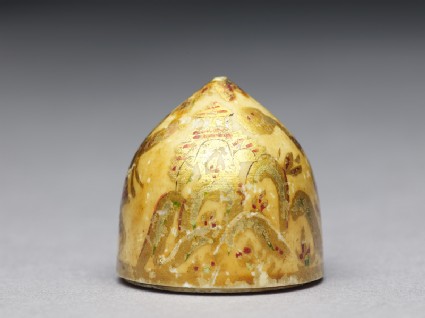Browse: 612 objects
- Reference URL
Actions
Part of...
Piece for the game of chaupar
-
Description
Chaupar or pachisi, the ancestor of the much simplified English ‘Ludo’, was one of the most popular Indian board games during the Mughal period. The emperor Akbar himself was a devotee and compelled his courtiers to play in tournaments which could last for months. The game was most often played by four players, each racing a set of four coloured pieces around a cruciform board according to the throw of dice. This full set of sixteen pieces is painted with courtly scenes, including princes on horseback and riding elephants, camels or chariots. It was evidently made for a royal court in Rajasthan, possibly Udaipur.
-
Details
- Associated place
-
Asia › India › west India › Rajasthan (place of creation)
- Date
- 2nd half of the 18th century
- Material and technique
- ivory, carved, with yellow and gold pigment, and lacquer
- Dimensions
-
2.8 cm max. (height)
2.9 cm max. (diameter)
- Material index
-
organic › animal › tooth › mammal tooth › ivory,
- Object type index
- No. of items
- 1
- Credit line
- Purchased, 1967.
- Accession no.
- EA1967.202.a
Glossary
lacquer
-
lacquer
Chinese and Japanese lacquer is made from the sap of the lacquer tree, which is indigenous to Eastern China. It is applied to wood as a varnish or for decorative effect. In India and the Middle East, lacquer is made from the deposit of the lac insect.
Location
Objects are sometimes moved to a different location. Our object location data is usually updated on a monthly basis. Contact the Jameel Study Centre if you are planning to visit the museum to see a particular object on display, or would like to arrange an appointment to see an object in our reserve collections.
Galleries
© 2013 University of Oxford - Ashmolean Museum






